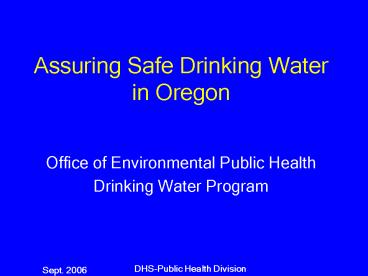Assuring Safe Drinking Water in Oregon - PowerPoint PPT Presentation
1 / 30
Title:
Assuring Safe Drinking Water in Oregon
Description:
Bottled water (a large business) Sept. 2006. DHS-Public Health Division ... bottled water! Sept. 2006. DHS-Public Health Division. How Does Oregon Compare? Sept. 2006 ... – PowerPoint PPT presentation
Number of Views:95
Avg rating:3.0/5.0
Title: Assuring Safe Drinking Water in Oregon
1
Assuring Safe Drinking Water in Oregon
- Office of Environmental Public Health
- Drinking Water Program
2
Oregons Drinking Water
- Who cares about it?
- Where do we get it?
- How safe is it?
- Whats needed?
- Whats next?
3
I. Who Cares?
- The Public. Providing healthy water is
something that government should be doing and do
well.(Kathy Figley, Mayor of Woodburn) - The Legislature. Assure Oregonians safe drinking
water. (ORS 448) - The Executive Branch. Help people become
independent, healthy, and safe. (DHS Mission)
4
II. Where Do We Get It?
- Public water systems - Tap water
- (3M people)
- 25 or more people served (US EPA/State law)
- 10-24 people served (State law, very small
systems) - Other sources
- Individual household wells (600,000?)
- Bottled water (a large business)
5
Oregons Public Water Systems by Type
6
Oregons Public Water Systems by Size
7
Where Do ContaminantsCome From?
- Source to tap
8
How To Protect Drinking Water?
- Source to tap
- Assess, protect water sources
- Test treat water adequately
- Protect distribution system
- Assure competent operators managers
- Inform, involve water consumers
9
Who Does What?
- A chain is as strong as its weakest link.
- Public Water Systems PROVIDE safe water
- Certified Labs ANALYZE , REPORT test results
- US EPA - SET minimum health standards
- State/County Public Health - ASSURE minimum
health standards are met - Consumers MAINTAIN house plumbing, flush taps
as needed, report concerns, stay informed
10
Current EPA Standards
11
More EPA Standards in 2005-06
- Parasitic microorganisms
- Disinfection by-products
- Arsenic (increased protection)
- Groundwater (most small systems)
12
And Still More to Come
- Radon
- Distribution protection
- Emerging contaminants?
- MTBE (gasoline additive)
- Perchlorate (rocket fuel, munitions)
- Endocrine disruptors (mimic hormones)
- Pharmaceuticals, personal care products
13
III. How Safe Is Oregons Drinking Water?
- Safer than it was!
- Whats been accomplished?
- What threats remain?
14
(No Transcript)
15
(No Transcript)
16
Oregons Sickening Six Contaminants
- Acute Diseases
- 1. Microbials - bacteria, viruses, parasites
(gastrointestinal illnesses) - Chronic Diseases
- 2. Lead (brain damage, learning disabilities)
- 3. Disinfection By-products (cancers)
- 4. Inorganic Chemicals (cancers, nervous
system/organ damage) - 5. Organic Chemicals (cancers, nervous system,
organ damage) - 6. Radioactive Contaminants (cancers)
17
Acute Diseases Success! (bacteria, viruses,
parasites )
18
What Threats Remain?
- Chronic diseases from long-term exposure to
chemicals. - Smaller EPA systems dont reliably meet all
health standards. - No help for very small systems.
- Unable to implement latest standards.
- How to implement future standards?
19
(No Transcript)
20
(No Transcript)
21
How Did We Get Here?
22
Whats Not Being Done?
23
IV. Whats Needed to Add Capacity? Workload
People
- Immediate need for existing EPA rules 11 staff
(2004 Drinking Water Task Force) - Additional need for 2006 EPA rules 2.5 staff (US
EPA) - Estimated need to assist 900 very small systems
5 staff (DHS)
24
People Dollars
- 18.5 additional State/county Public Health staff
1.5M per year - 1.5M 50 cents per Oregonian
- 50 cents half the price of a single 20 oz.
bottled water!
25
How Does Oregon Compare?
26
V. Whats Next? Choose from 3 policy options
- 1) FIX IT Add Capacity
- Authorize sanitary survey inspection fee (est.
100K/yr 100K/yr Federal Match), and - Increase general funding (1.3M/yr),
- and
- Establish statutory Drinking Water Advisory
Committee.
27
OR
- 2)TREAD WATER Do Nothing
- Continue with 1/3 program
- Very small systems receive no help
- Delay adopting new EPA standards (2 years max),
Water Suppliers on their own with EPA. - State County public health continue to struggle
28
OR
- 3) RETURN (OR LOSE) PRIMACY
- Cede state power and authority over all EPA
drinking water systems in Oregon. - Communities lose access to successful Drinking
Water Revolving Fund - 12 M/year in EPA capitalization grants
- 115 M in loans made to date
- 33 M in savings to communities so far
29
Oregons Drinking Water
- Who cares about it? Everybody!
- Where do we get it? Thousands of public water
systems statewide - How safe is it?
- Safer than it was, acute diseases are down
- Water systems, especially smaller ones, need more
help attention - Chronic disease threats remain
- Whats needed? Minimum credible oversight
- Whats next?
- Eliminate safety disparity between big and small
water systems - Build capacity to assure all needed health
protections at all Oregon systems
30
For More Information!
- 971-673-0405
- oregon.gov/dhs/ph/dwp































